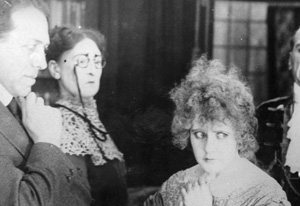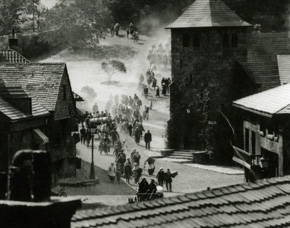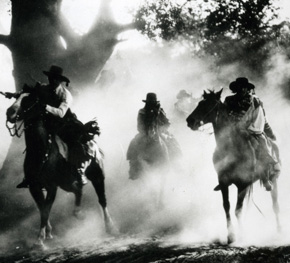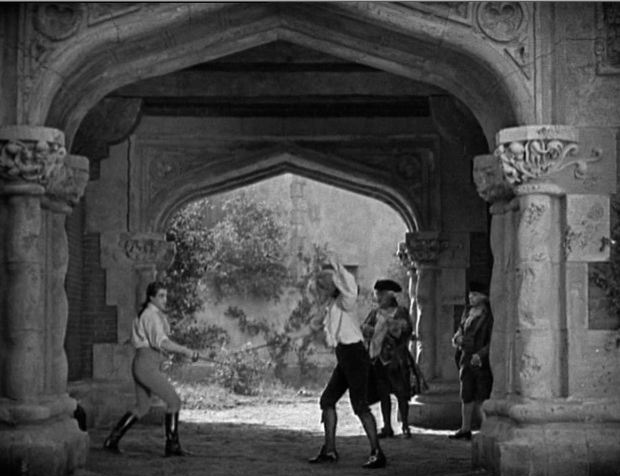At The Universal Film Manufacturing Company, Rex Ingram finally made the break into film direction, starting with the short film, The Symphony of Souls, with Robert Z. Leonard and Ella Hall, released in 1914 by one of Universal’s subsidiary companies, The Rex Motion Picture Company. His real breakthrough came in 1916 with the Violet Mersereau vehicle, The Great Problem, which he wrote and directed. By now he had been moved from The Rex Motion Picture Company to Bluebird, a new brand set up by Universal in 1916 to cater specifically for mainstream audiences. The trade press response was not encouraging: “How in the name of goodness anybody could have written such a consistently commonplace scenario is difficult to imagine,” Variety pronounced, gleefully delineating the absurdities of the plot. Luckily for the novice writer-director, his second film for Bluebird, a production conceived at Fox and again starring Violet Mersereau, Broken Fetters (1916), received an altogether warmer reception, garnering praise for plot, acting and setting.

It was with his third Bluebird production that Ingram really hit his stride. Between this release, The Chalice of Sorrow (1916), and his previous production, two important changes took place. The first was that Universal moved its production base from New York to Los Angeles. The second was the employment of “Duke” Hayward as the film’s cameraman. Hayward was an intensely talented cinematographer whose ability to manipulate shadow and light reinforced in Ingram the conviction that the new medium of motion pictures was the most exciting art form of the twentieth century. “No picture shown within many weeks comes to mind in which the light effects have been so brilliantly handled. A fine painter could not have managed his shadow effects better,” Variety now exulted. In the environs of Los Angeles, Rex found the exotic settings he had been forced to create artificially in New York. In the film, authentic outdoor locations are matched with elaborate interiors, soon a recognisable Ingram trademark. Ingram continued to make a further four pictures with Bluebird, gradually creating a repertoire of works that combined melodrama, visual artistry and a baroque fascination for the grotesque. Once again, he fell out with his employers and once again he moved on, working briefly with Paralta Plays Inc. before joining the Royal Canadian Flying Corps. The war ended before he could see service but Ingram came back to Hollywood an ill man. Only through the good offices of his more influential friends did he return to film direction, making The Day She Paid for Universal in 1919, in which a young Alice Terry played a small role and Under Crimson Skies (1920) for Universal’s prestige label, Jewel. Now, his health restored, Rex was ready for yet another move, this time to Metro Studios.

An introduction to the influential Metro executive, Maxwell Karger (soon after to be best man at Valentino’s disastrous wedding to Jean Acker) led to a contract for $600 a week to direct Shore Acres (1920), an adaptation of the popular, if now dated James Herne play starring Alice Lake. But it was his second film at Metro, Hearts are Trumps(1921) that threw Ingram together with one of the studio’s most influential figures, June Mathis. At the age of just 27, Mathis had become chief of Metro’s script department and was renowned for her work ethic, and the meticulous approach she brought to the preparation of scenarios. More experienced and more senior to Ingram, she was quick to notice the young man’s talents; indeed her reputation was in part based on being a “maker of young men.” Alice Terry too played in this film, as did another soon-to-be Ingram regular, Edward Connelly. The great cinematographer, John Seitz, was behind the camera, a position he too was to take over and again, working with Ingram on some of his most successful pictures, and another long-time collaborator, Grant Whytock, was the film’s editor. It was Mathis who was responsible for insisting that the still little-known Rex Ingram be hired as director on her next major project, an adaptation of Vicente Blasco Ibáñez’s best-selling novel, The Four Horsemen of the Apocalypse. She too insisted on the casting of another minor Hollywood actor, then known as Rudolfo Valentino, in the lead role of Julio Desnoyers, opposite Alice Terry. Massive in concept and execution, it was an extraordinary gamble to place Ingram at the helm of this tale of romance and war. The set-pieces required him to run twelve or fourteen cameras simultaneously; the battle scenes saw him in command of hundreds of extras; shooting took place indoors and outdoors, alternating between scenes of intimate domesticity and the massive clash of armies. The result was to transform his career; elevating his reputation alongside that of D.W. Griffith and the great pioneers of the moving pictures. On its release in early 1921, praise was lavished equally on the film’s pictorial qualities and its performances, with the Los Angeles Times noting presciently that: “In the interpretation of Julio, Valentino has assumed a place among the most dominant romantic actors of the screen.” Variety pronounced it “a production that, in all its elements, comes nearer the ideal than anything which has gone before.” Audiences flocked to the film at home and overseas (although the depiction of the German characters went down poorly in Germany).

Although Ingram was dismissive of Valentino, he spent much of the rest of his career in pursuit of that Latin lover look in his leading men, making a star of Ramon Novarro along the way, and much later (and less successfully) luring Pierre Batcheff to be his lead male in a similar type of role. For now, he was the jewel in Metro’s crown, a director who could bring in the much sought-after middle-class audience while making movies that were highly profitable, not least because of the inflated price of their tickets. Keeping to his favoured collaborators (minus Mathis), he now alternated between small-scale domestic melodramas, exotic adventures, and lavish epics. The first category includes Turn to the Right (1922); the second, Where the Pavement Ends (1923); the third, The Prisoner of Zenda (1922), Scaramouche (1923). However, behind the scenes at Metro, life for Ingram was becoming increasingly fraught. He was just one of a number of directors hired by the studio whose maverick personalities saw them push the boundaries of filmmaking, stamping their own ferocious individuality on their works – others included Marshall (Micky) Neilan, King Vidor, and Eric von Stroheim. With the new streamlining of Hollywood production, such personalities had to conform to a model of filmmaking that increasingly placed control in the hands of production executives and downplayed the importance of the director. The firing of von Stroheim from Merry-Go-Round in 1922 was a signal from the top as to who was in control. On 16 May 1924, Marcus Loew merged Metro Pictures with the Goldwyn company and Louis B Mayer Productions, and out of this Metro-Goldwyn-Mayer was born. With Louis B Mayer came his newly-appointed production head, Irving Thalberg. Ingram was completing his sheikh film, The Arab, starring Ramon Novarro and Alice Terry and welcomed the development frostily. When the debacle over Ingram’s friend von Stroheim’s 42 reel version of Greed blew up – Ingram was the only person von Stroheim would allow touch his masterpiece and Ingram refused to remove more than 6 reels – it was clear that the writing was on the wall for the Metro mavericks. The final nail in the coffin came when Ingram failed to secure the direction of one of the most prestigious pictures of the early 1920s, Ben Hur. Yet Ingram’s films made money and although Louis B. Mayer hated the Irishman’s working methods, he recognised his value. Even The Arab, for all its lack of originality of plot, was a feast to the eyes and a guaranteed box office hit.

Since mid-1921, Ingram had been dropping hints of his future plans to journalists: “Just two more pictures, and then I shall be on my way to Europe,” he announced to one. Throughout 1922, the papers continued to report on Ingram’s desire to settle in the South of France, with his now-wife Alice Terry. Marcus Loew remained an ally of Ingram’s at the newly established MGM and soon after the merger was completed, he arranged for Ingram to remove himself to the Victorine Studios in Nice with much of his production company. MGM would cover the cost of the renovation of the studios and continue to finance Ingram’s productions. It was a good deal and Ingram didn’t hesitate. He and Alice Terry took themselves without ado to Nice. From now on, no mention of Louis B. Mayer would grace Ingram’s pictures, which were announced simply as Metro-Goldwyn productions.
At the Victorine Studios, Ingram assembled around him a cosmopolitan grouping of friends and co-workers. Alice Terry continued to star in his films, John Seitz to shoot them and Grant Whytock to edit them (both Seitz and Whytock left after The Magician [1926]). The first film shot in Nice was another Vicente Blasco Ibáñez adaptation, the spy story Mare Nostrum. With no one to curb his activities, Ingram spent 15 months shooting and finally produced over one million feet of processed film. Even after rigorous cutting, the audience at the film’s premiere were, the Los Angeles Timesreported, “enthusiastic, though bewildered.” The New York Times agreed, observing that the “audience … appeared to be left slightly dazed by the weird delivery of the film.” Weirder was to come with The Magician (1926), a loose version of the Alastair Crowley story, adapted from Somerset Maugham's original novel. The split with MGM finally came on the completion of The Garden of Allah (1928). L.B. Mayer attempted to intervene and change the ending. Ingram flatly refused. The film once again boasted unparalleled location photography (in Algeria) but the plot was patchy and poorly paced. Now Ingram was on his own. He bought the Victorine Studios and proceeded to shoot two last films. The first, The Three Passions (1929), was his final silent film but, released after the introduction of sound, it was sadly dated. Ingram’s final film was Baroud/Love in Morocco (1932). It was his first excursion into sound, and another wonderful picture of North Africa. But the new technology defeated the master of the silent era, and to complicate matters he insisted on playing one of the characters in the English-language version (the other version was French). The critics were at best lukewarm and, sixteen years after directing his first film, Rex Ingram retired from motion pictures.